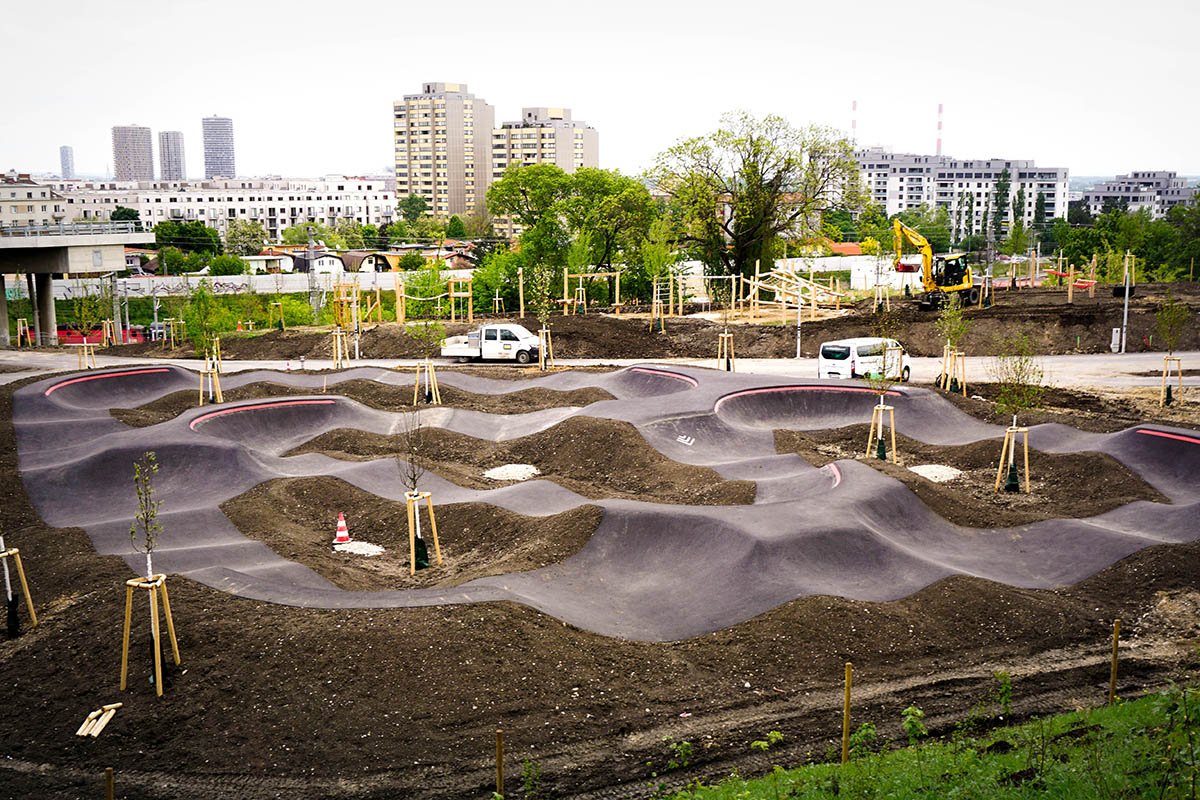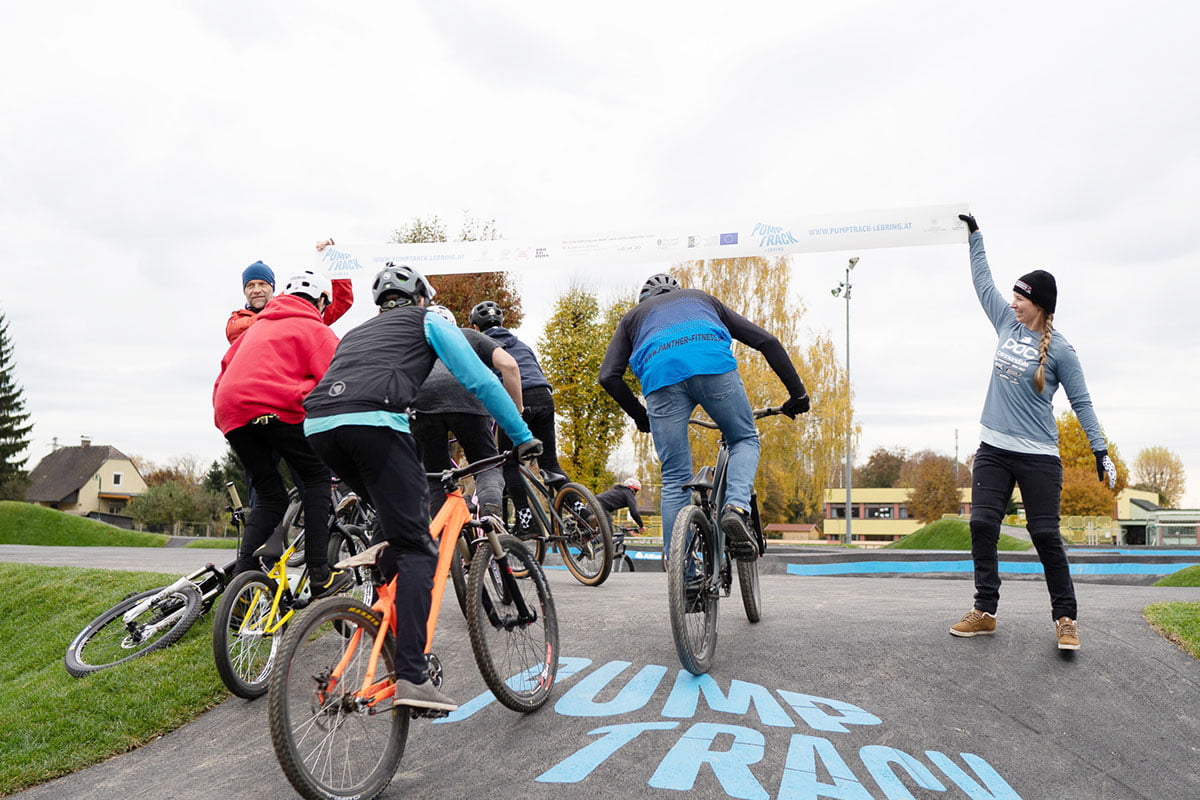
What is a pump track?
Pump tracks represent a rapidly growing trend in the field of sports infrastructure. In the last two years, we have built over 40 such pump tracks in 8 countries. What a pump track basically is, can be read in the next few paragraphs below.
A pump track presents:
- An attractive and safe outdoor sports facility,
- An asphalt circuit with rhythmically connected rollers and banked turns,
- A sports facility suitable for bicycles, skateboards, skates, scooters and other sports equipment on wheels,
- A sports facility suitable for users from 2 to 70 years of age,
- A gathering place for local communities,
- An innovative way of riding while constantly changing the centre of gravity,
- A physically intense way of movement,
- A sports facility that encourages the development of balance and coordination,
- A sports facility that can be placed in close proximity to its users,
- A permanent facility that needs minimal maintenance,
- A facility in a terrestrial, concrete, asphalt or modular version.

History
Pump tracks were first introduced in the 1970s. At that time, they represented mainly smaller versions of BMX tracks and enabled the development and adoption of certain cycling skills. They were very similar to the so-called snake runs in skate parks. In the 1990s, mountain bikers also started to use pump tracks and adapted them to their needs. Pump tracks, which were then built exclusively out of dirt, began to spread around the world and grew in many public areas as well as private courtyards. Since they were made of dirt, these tracks were accessible to everybody, but on the other hand, they were suitable only for cyclists, and they were not able to be used in bad weather until the surface was dry. Dirt pump tracks must be frequently maintained due to mechanical wear and weather conditions, whereby specific knowledge and experience for doing so is required.
As enthusiasts quickly lose their will to maintain them, and public service employees do not have the necessary know-how to maintain them, managers of such facilities can get accused of negligence in the event of an accident. Dirt pump tracks are still popular today due to low costs and possibilities of continual adjustment, especially for individuals and clubs that cannot afford asphalt versions but have the necessary skills for building and maintaining them. Builders have tried to upgrade dirt pump tracks with concrete, which offers durability, the possibility to use them in all weather conditions, and to ride them with other sports equipment on wheels. However, due to the time-consuming construction process and consequently high prices, such tracks have not been widely implemented. On the contrary, the pump tracks have reached true expansion with asphalt coating. Asphalt has practically the same characteristics as concrete, but the surfacing is less complicated and cheaper.
Asphalt pump tracks have thus become a global trend in the field of sports facilities since 2015, which has expanded to Slovenia, currently boasting the largest number of asphalt pump tracks per capita.
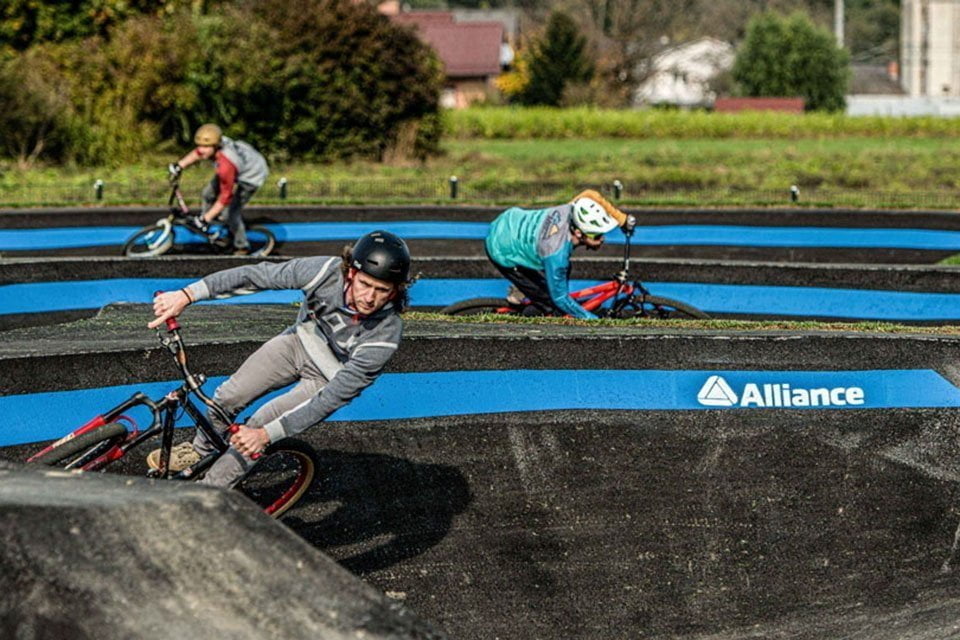
Ways of Use
Pump tracks are distinguished by the innovative way of movement, where we do not use pedals or the force of pushing, but move on the rollers by moving the centre of gravity of the body up and down. Thus, when climbing on the roller, the bicycle or other equipment is relieved, and when we descend from the roller, we create momentum again. This kind of movement is physically intense and allows the training of youngsters as well as top athletes. In addition, riding on pump tracks strengthens the development of balance and coordination, which is important for the development of motoric skills in children and youth.
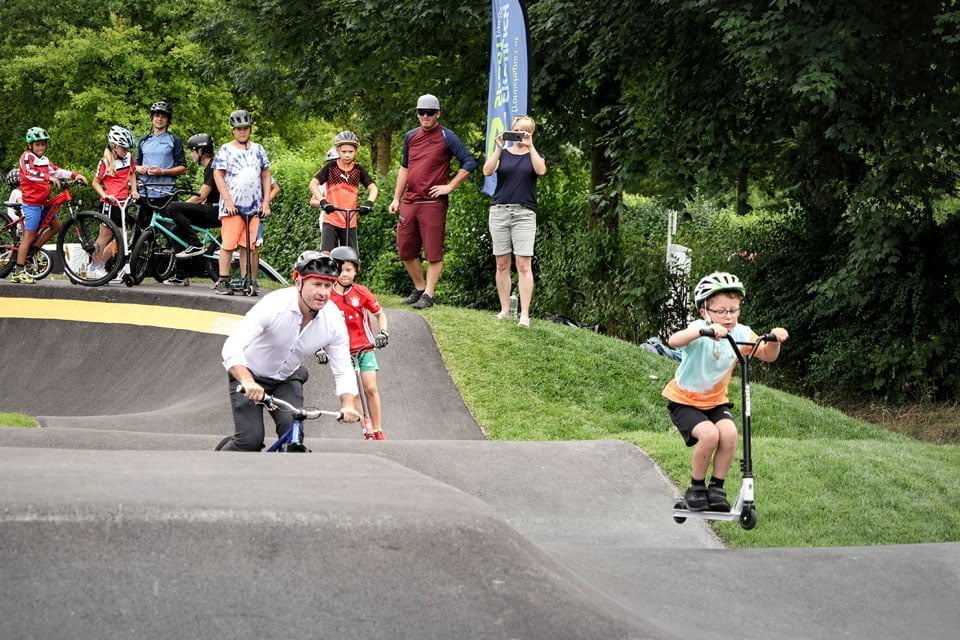
Types of Pump Tracks
Pump tracks were initially built of dirt because this type of construction is simple and inexpensive, but at the same time, it also makes it easy to be changed and upgraded. However, since the dirt pump tracks need to be constantly maintained, and at the same time they can be used only by cyclists, the builders have started looking for more permanent solutions. First, there were concrete pump tracks, which are very expensive and complicated to construct. On the other hand, modular pump tracks, built of wood, metal, concrete, or composite fibres, were also introduced. Such a pump track otherwise solves the aforementioned issues, but due to its modularity, it is very monotonous and therefore less suitable for permanent placements. On the contrary, these kinds of pump tracks for quick and easy assembly and disassembly are ideal for temporary placement, such as different events, competitions etc.
In the course of time, asphalt pump tracks have proven to be the most optimal as they are cheaper than the concrete version, they are diverse and organic in shape, they are durable and resistant to weather, they allow to be used with almost all sports equipment on wheels and basically don’t need any maintenance. Consequently, these pump tracks are also the most widespread. Read more about the types of asphalt pump tracks – all the advantages and disadvantages of individual versions can be found in these articles.
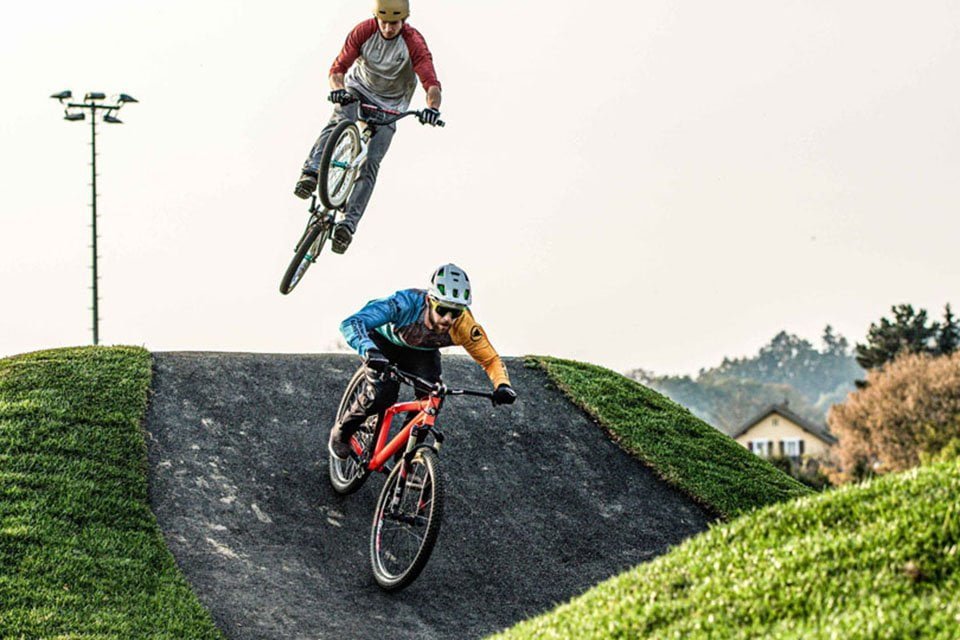
Design and Construction
The design of the pump track is adapted to the main target group of users, the number of potential users, the available resources, and the area where the pump track is to be placed. The design of the pump track is so diverse, which adds to their attractiveness even more since every pump track tends to be unique. Pump tracks can be placed on small areas of 400m2 and up, allowing them to be placed in urban environments. On the other hand, such pump tracks can also be placed in areas of several thousand square meters. While smaller ones are especially suitable for the youngest users on scooters, and beginners, larger pump tracks are also suitable for older, more experienced users, as well as cyclists and skateboarders. An appropriate size for a specific place also depends on the number of potential users. The most common pump tracks are in the size of up to 1000 m2, as they are already large enough to be suitable for older users as well as for a wide range of sports equipment. You can find more information about choosing a suitable location for a pump track here.
Pump Track Construction
The construction of a pump track depends on the type and way of construction. Dirt pump tracks are the easiest to build and can be built in a very short time. For the dirt version, the most important is the use of a suitable soil mixture, which allows achieving the desired degree of compaction, while retaining moisture for longer periods, even in dry weather, preventing decay. A mixture of clay and arenite in a ratio of 30:70 is recommended. In addition, various preparations are also available for stabilizing the soil, for example, Soiltec or various homemade mixtures based on wood adhesives, etc. It is advisable to provide drainage prior to building a dirt pump track, and it is reasonable to cover the soil on the banks permanently in order to increase its stability.
Asphalt versions require a greater degree of field consolidation to prevent the shrinking of material that can cause cracks on the asphalt surface. In this part, it is necessary to remove the humus layer and replace it with suitable stone material. Drainage is also necessary, most often through concrete shafts connected with pipes that discharge water outside the pump track itself. With the help of machines and handwork, the configuration of the pump track itself from the frost-resistant material is formed and consolidated on the prepared plateau. The structure itself is then coated with a layer of asphalt with a suitable granulation, which provides a smooth and solid surface. The pump track banks must be covered with grass to prevent the lower layer of the pump track from rinsing and eroding.
Similar is also the technique for constructing a concrete pump track, but it is necessary to enclose the entire pump track with formwork, and then apply the concrete with the shotcrete technique.

Pump Tracks and Safety
Pump tracks seem to look very diverse and for some also dangerous. However, in contrast to the first impression, they are very safe, which is supported by the fact that we have also obtained the Certificate of Conformity with the European and Slovenian standards for playgrounds for our asphalt pump tracks. Read everything you ever needed to know about Pump Tracks and Safety.
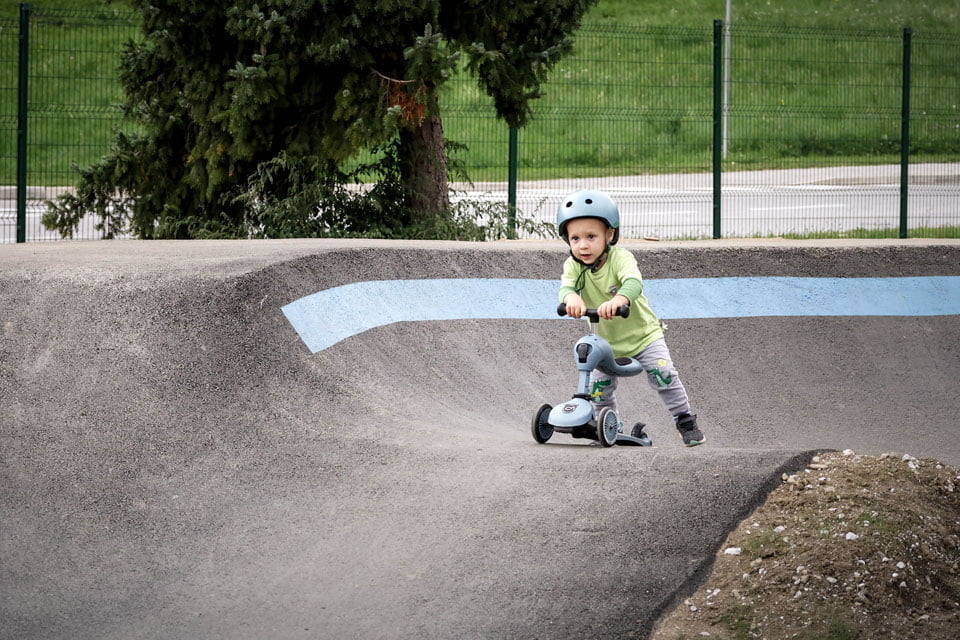
Competitions on Pump Tracks
Various events and competitions can be organized on pump tracks. Some pump tracks are specially designed for the organization of competitions and allow the simultaneous ride of two competitors on two pump tracks with exactly the same circuit, again on others it is possible to organize competitions on time, etc. Due to the popularity, the rapidly growing number of such pump tracks around the world, and the existing competitions, riding on pump tracks has been recognized as an official sports discipline by the UCI International Cycling Association. Consequently, national, European, and world championships will be held on pump tracks.
We support Austrian Pumptrack Serries, Pumpaj Slovenija and Hungarian national pumptrack cup.
